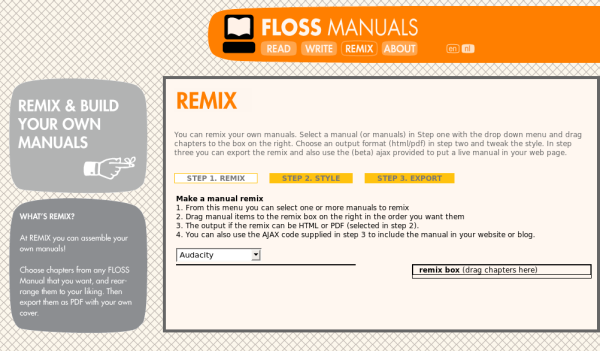
A few years ago, I wrote a brief post on Remix vs Shuffle. At the time, the Open Educational Resources (OER) movement was struggling to work out how existing teaching materials could be remixed and reused. No one had really cracked it. At the same time, we built remix into FLOSS Manuals. The primary use case was for workshop leaders to be able to compile their own workshop manual from existing resources. We had a large enough repository of works, so it was a question of how we went about enabling remix.
Recently, I have been in two separate conversations about remix (after not having thought or talked about it for some time). One conversation was in the context of OER, the other in the context of remixing many journal articles into a Collection. So, I’m revisiting some earlier thoughts on the topic and updating etc…
At the time, we expected the FLOSS Manuals remix to be used a lot. I was a workshop leader myself and thought I could benefit from the feature. However, remixing wasn’t used very much by me (I did get some very useful manuals from using it, but didn’t use it often) or anyone else. Hence I wrote the reflection on remix (linked above). My position is outlined by the following quotes from that article:
I have come to the understanding the ‘remix’ as such has only a limited use when it comes to constructing books from multiple sources.
And the following, where I liken book remix to remixing of music to illustrate the shortcomings:
Text requires the same kind of shaping. If you take a chapter from one book and then put it next to another chapter from another book, you do not have a book – you have two adjacent chapters. You need to work to make them fit together. Working material like this is not just a matter of cross-fading from one to the other by smoothing out the requisite intros and outros (although this makes a big difference in itself), but there are other aspects to consider – tone, tempo, texture, language used, point of view, voice etc as well as some more mundane mechanical issues. What, for example, do you do with a chapter that makes reference to other chapters in the book it originated from? You need to change these references and other mechanics as well as take care of the more tonal components of the text.
I think these are valid points, but I think, revising this, there is one nuance I would like to add. Sometimes ‘shuffling’ is adequate where you are compiling an anthology which is, as it happens, the case when you are putting multiple journal articles into a collection. Building tools to enable this kind of ‘reshuffle’ is very useful but still I would question the usefulness in certain contexts. It is a use case that, from my experience, would be great as a tool used by, for example, a publisher or curator. I’m not sure of its usefulness in a more generic ‘user space’. Journal publishers do, in fact, make collections where several articles are compiled together to form one ‘bound’ work (often a PDF). In this space, such a tool could make life much easier. Whether members of the research community, for example, would want, need, or use such a tool is still an open question to me.
For information on how FLOSS Manuals Remix worked see here:
http://write.flossmanuals.net/floss-manuals/remixing/
It is still working here:
http://archive.flossmanuals.net/index.php?plugin=remix
Here is a video (ogg vorbis) demo of it in action, with the resulting PDF linked below.
my_pdf (note, the colored text is because, as shown in the demo above, I edited the styles via CSS to make the body text red).
video made with recordmydesktop.